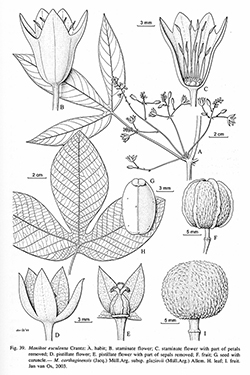e-Flora of Thailand
Volume 8 > Part 2 > Year 2007 > Page 438 > Euphorbiaceae > Manihot
2. Manihot esculenta Crantzwfo-0000235507
Inst. Rei Herb. 1: 167. 1766; Airy Shaw, Kew Bull. 26: 308. 1972; D.J. Rogers & Appan in Fl. Neotropica 13: 25. 1973; Veltkamp & G.H. de Bruijn in PROSEA9: 107. 1996; Welzen, Nguyen & Chung, Rheedea 7: 80. 1997. Fig. 39: A-G.
Accepted Name : This is currently accepted.
Synonyms & Citations :
Description : (Herb to) shrub (to treelet) up to 7 m high, sparingly branching; branchlets often tinged reddish. Stipules entire or somewhat split. Leaves: blade basally attached or slightly (up to 2 mm) peltate, dark green above, pale light greenish greyish underneath, sometimes variegated; lobes narrow, 2.9–12.5 times as long as wide; central unlobed part usually short, lobes 15–21 times as long as unlobed part; nerves in 5–18 pairs, usually not very distinct, especially above, veins reticulate to scalariform. Inflorescences lax, with 3–5 together in fascicles. Staminate flowers: calyx divided to halfway or more, green to white to reddish, glabrous except for apex of tube and inner side of segments; filaments white; anthers yellow; disc yellow to light orange. Pistillate flowers: calyx green with red margin and midrib, hairy along the margin and on the midrib inside; disc pink; ovary with 6 longitudinal ridges, green to orange; pistil and stigmas white. Fruit subglobose, green (to light yellow, white, dark brown), with 6 longitudinal wings. Seeds up to 12 mm long.
Thailand : NORTHERN: Chiang Mai (Doi Chiang Dao, Doi Suthep), Lamphun (Doi Khun Tan), Phitsanulok (Thung Salaeng Luang); SOUTH-WESTERN: Prachuap Khiri Khan (Pa Nam Phut); CENTRAL: Saraburi (Sam Lan); SOUTH-EASTERN: Chanthaburi (Khlung); PENINSULAR: Phangnga (Luk Sua Cave), Phuket (Patong Beach), Nakhon Si Thammarat (Young Falls), Pattani (To Mo). Probably in many more places.
Distribution : Probably originally cultivated in NE Brazil, nowadays only known from cultivation and found throughout SE Asia and Malesia.
Ecology : Cultivated or found in waste places of mainly abandoned gardens and along roads, probably not escaped; locally common; soil: clay, limestone, red loam, peaty soil, usually well-drained; 0–1,700 m alt. Flowering and fruiting: whole year through, though less so in September and October. See also Veltkamp & de Bruijn 1996.
Vernacular : Tang ban (ต้างบ้าน), tang noi (ต้างน้อย)(Northern); man sampalang (มันสําปะหลัง), man samrong (มันสําโรง), sampalang (สําปะหลัง)(Central); man hio (มันหว)(Phangnga); man mai (มันไม้), man tan (มันต้น)(Peninsular); u-bi-ka-yu (อุบีกายู)(Malay-Peninsular).
Uses: The roots constitute one of the world’s most important stock crops for starch. It is mainly used for human consumption, less for animal consumption and (far less) for industrial purposes, though this may be very different depending on the country (Thailand mainly animal fodder). Presently, one of the most important stock crops in the Northeastem of Thailand. The roots can rarely be eaten fresh and are usually cooked, steamed, fried or roasted when fresh or after drying or fermenting. It is advisable to peel, grind or cut, and dry the roots in order to diminish the contents of cyanogenic glucosides (mainly linamarin). Only sweet cassava can be eaten fresh in small quantities (the peel contains most HCN); the bitter ones have to be treated due to a much higher HCN content. The leaves are also eaten, they contain reasonable amounts of carotene and vitamin C, though they too have to be cut in pieces and they have to be cooked to rid the HCN. Food poisoning hardly occurs, because most people know how to prepare the roots and leaves. See also Veltkamp & de Bruijn 1996. Plants, especially with variegated leaves, are also used in horticulture. No satisfactory system of classification exists for the manifold of cultivars.

